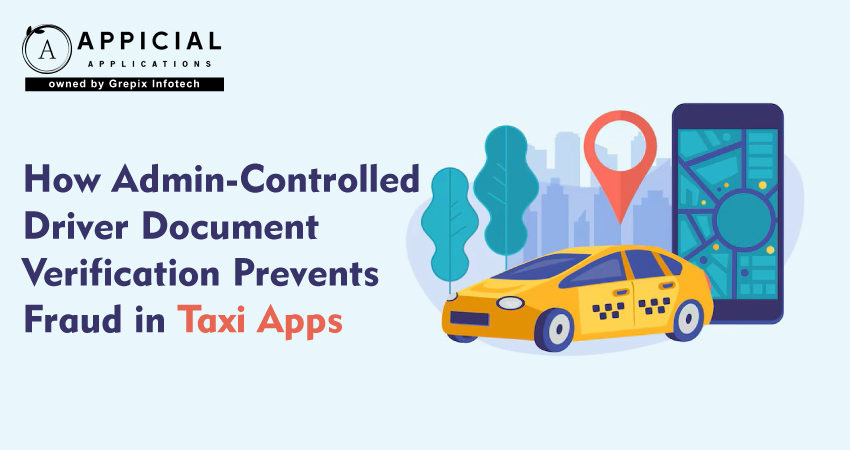
How Admin-Controlled Driver Document Verification Prevents Fraud in Taxi Apps
Fraud is a serious threat in taxi app ecosystems. When driver registration is weak, fake or manipulated documents can allow malicious actors to gain access.
These actors can impersonate legitimate drivers, commit unauthorized rides, or violate safety protocols. In a ride-sharing app or ride-hailing app, passenger trust is foundational. By controlling driver document verification through an admin dashboard, platforms can filter out fraudulent or inauthentic registrations before they become active.
In this article, we unpack how admin-controlled verification works, why it is vital, and how to architect it in Uber Clone or e-hailing app solutions.
In this blog, we examine how admin-controlled driver document verification acts as a powerful line of defense against fraud in taxi apps. We describe the types of fraud in ride-hailing platforms, why document verification matters, technical and operational strategies, and how to integrate this in Uber Clone, ride-sharing app, ride-hailing app, e-hailing app frameworks. We compare verification in white label taxi booking app systems versus custom builds from a taxi app development company. We also answer key questions about time, cost, privacy, and best practices..
Understanding Fraud Risks in Taxi Apps
What types of fraud occur in ride-hailing systems?
- Fake documents/identity fraud: Drivers upload falsified licenses, identity cards, or vehicle papers. Reports show that in the mobility sector, fake documents account for about 50% of identity fraud cases. S
- Account takeover: A fraudster hijacks a driver’s account or reuses credentials.
- Incentive abuse: Some drivers set up fake passenger accounts to accept their own rides to inflate metrics.
- GPS spoofing/location manipulation: Drivers manipulate location data to gain an unfair booking advantage.
- Detours and fare inflation: Drivers exploit the lack of transparency to take longer routes or overcharge. A taxi field experiment found that many drivers take detours when passengers seem uninformed.
These frauds damage reputations, incur financial losses, and reduce user trust. A white label taxi booking app or custom system lacking strong verification is especially vulnerable.
Why is identity verification central
Driver document verification helps ensure that the registered driver is real and authorized. It prevents fake accounts from becoming active. It adds a barrier against impersonation and fraudulent registrations. In mobility platforms, identity verification includes document checks, liveness detection, background checks, and ongoing revalidation.
When verification is admin-controlled, each document goes through human or automated scrutiny before approval. That reduces false positives and catches subtle fraud. It also allows support teams to query suspicious cases.
What are the Key Components of Admin-Controlled Driver Document Verification?
Document upload and validation
Drivers should upload scanned images or photos of their driver’s license, identity card, vehicle registration, and insurance. The admin dashboard should receive these documents. The admin panel must show clear previews, metadata (upload date, file type), and validation statuses (pending, accepted, rejected).
Automated document authenticity checks
The system should run automated checks:
- OCR (Optical Character Recognition) to read text fields
- Security mark detection (holograms, watermarks)
- MRZ or barcode decoding
- Tampering detection (edges, inconsistent fonts)
- Expiry validation
These checks quickly flag obviously invalid docs, reducing admin workload.
Liveness / selfie + face match
After document upload, drivers must submit a live selfie or short video. The system compares face from the document photo with the live image. Liveness detection ensures that it is not a static photo or manipulated image. This prevents fraudsters from reusing someone else’s ID.
Background checks and third-party data verification
Admin should integrate or request criminal background checks, driving history, or national identity databases. The admin interface should include links or APIs to government or licensed verification services. This step adds depth to verification beyond documents.
Manual review & decisioning
Some cases may require manual review. The admin team can inspect documents, check consistency, contact drivers for clarifications, and make an accept/reject decision.
Admins should maintain audit logs: who approved, when, on what basis. This ensures accountability.
Periodic revalidation & audits
Verification should not be a one-time event. Drivers may need to reverify documents after expiration or periodically (e.g. annually). Random audits catch fraud attempts that occur post-onboarding. The admin system should flag upcoming expiries.
Suspicious case escalation
When verification checks fail or inconsistencies arise, the admin dashboard should escalate the case. Admins may request additional documents or block the account until resolution.
These components, when combined, create a robust gatekeeper that prevents fraudulent drivers from entering the system in Uber Clone, ride-sharing app, or ride-hailing app environments.
How Admin Verification Prevents Fraud — Mechanisms & Benefits?
Blocking fake identities before activation
By verifying every driver document before approving it, the system prevents fake accounts from ever going live. This reduces risk, avoids fraudulent rides, and ensures only authentic drivers operate.
Reducing insider abuse
Even authorized users may attempt misbehavior later. Periodic revalidation and audit checks prevent misuse, such as document swapping or account sharing. Admin oversight helps catch anomalies early.
Enhancing passenger trust and retention
Passengers see the driver’s name, license photo, vehicle registration, and star rating. When they know that the platform has enforced document verification, they feel safer. Safety drives retention and positive word-of-mouth.
Mitigating financial loss & chargebacks
Fraudulent accounts can cause chargebacks, ride cancellations, and refunds. Catching fraud early means fewer disputes and fewer financial losses. The platform's liability decreases.
Compliance & regulatory protection
In many jurisdictions, taxi or ride-hailing regulators require driver licensing and document verification. Admin control ensures compliance and helps the platform avoid fines or shutdowns.
Reputation protection
Publicly known fraud or safety incidents can damage a brand. By enforcing strong driver verification, a white label taxi booking app or custom solution maintains its reputation.
Enabling smarter monitoring & analytics
Admin logs on to verification trends, rejection rates, and flagged documents to provide analytics. The platform can adjust thresholds, add checks, or detect patterns of fraud attempts.
How to Integrate Admin Verification into Taxi App Architectures?
In Uber Clone/ride-hailing app frameworks
In an Uber Clone or ride-hailing app setup, the driver onboarding workflow includes a “document upload → automated check → admin review → activation” path. The driver cannot accept rides until verification is approved. The verification module sits between onboarding and go-live.
In a white label taxi booking app platform
A white label taxi booking app often includes plug-in or module support for document verification. The platform provider should provide admin verification dashboards and APIs. Customization is needed to support specific document types or governmental standards.
Admin dashboard design considerations
The admin panel should be intuitive. Use filters (pending, failed, expired). Show high-res thumbnails. Provide buttons for accept, reject, and request more documents. Show verification history. Flag accounts with repeated issues.
API & microservice architecture
Verification logic should be modular (a microservice or module). Other parts (driver app, ride matching, payment) should call the service to check whether a driver is verified before scheduling rides. This modularity ensures maintainability and upgrades.
Notifications & feedback to drivers
Drivers should see verification status updates (pending, accepted, rejected). If rejected, the reason must be shown (e.g. “license expired”, “photo mismatch”). This clarity reduces confusion and repeated errors.
Scalability & performance
As driver applications grow, the verification system must scale. Automated checks should operate efficiently. Admin panels must handle large document queues. Use caching, queues, and background processing.
What are the Challenges & Best Practices?
False positives and user frustration
If verification is overly strict or error-prone, genuine drivers may get rejected mistakenly. That leads to churn and negative sentiment. Balance strictness with sensitivity. Offer clear guidelines and retest options.
Privacy, data security, and compliance
Storing sensitive documents (IDs, driver licenses) requires high security. Use encryption at rest and transit. Limit access logs. Comply with data privacy laws (GDPR, local equivalents). Ensure secure deletion of expired documents.
Local document formats & standards
Different countries have different license formats and security features. The admin system must handle local formats. In a taxi app development company project, developers must build document parsers tuned to local IDs.
Integrating external databases
Some jurisdictions permit API access to national ID or driving databases for verification. When permissible, linking these databases strengthens verification. If not, manual verification or third-party services are needed.
Also Read: Taxi App Features | Taxi Booking App Features List
Ongoing maintenance & updates
Document security features evolve. Fake IDs become more sophisticated. The verification system must be updated. Regular review and adaptation keep fraudsters at bay.
Balancing speed vs security
Users want fast onboarding, but security demands caution. Use automated checks first to speed approvals, and reserve manual review for flagged or border cases.
Statistics & Evidence Supporting Verification
- In mobility, fake documents represent about 50% of identity fraud cases.
- Account takeover fraud in ride sharing rose sharply in recent years.
- In U.S. ridesourcing, over 95% of surveyed users consider pre-ride safety features (driver name, photo, license plate) very important.
- Studies in taxi industries show that when passengers seem uninformed (about routes or tariffs), drivers are more likely to take detours or overcharge.
These data points show that fraud is real. Preemptive verification matters.
Conclusion
Admin-controlled driver document verification is a critical shield in taxi app ecosystems. It prevents fake registrations, reduces fraud losses, increases passenger confidence, and supports compliance with regulatory norms. Any robust Uber Clone, ride-sharing app, ride-hailing app, or e-hailing app should incorporate a well-designed verification module.
When launching via a white label taxi booking app or partnering with a white label taxi app development company, ensure that the verification system is configurable, secure, and auditable. When working with a taxi app development company on custom projects, insist on modular, scalable, and secure verification architecture.
If you're planning to build or upgrade a taxi or ride hailing app and want to embed strong fraud prevention from the start, partner with Appicial Applications. The team designs and integrates advanced driver document verification modules, builds intuitive admin dashboards, and offers full end-to-end taxi app development, including Uber Clone style systems. Reach out now to start building a secure, trustworthy ride platform. Click here to contact Appicial Applications today.
FAQs
Author's Bio

Vinay Jain is the Founder at Grepix Infotech and brings over 12 years of entrepreneurial experience. His focus revolves around software & business development and customer satisfaction.
Back to blog list




